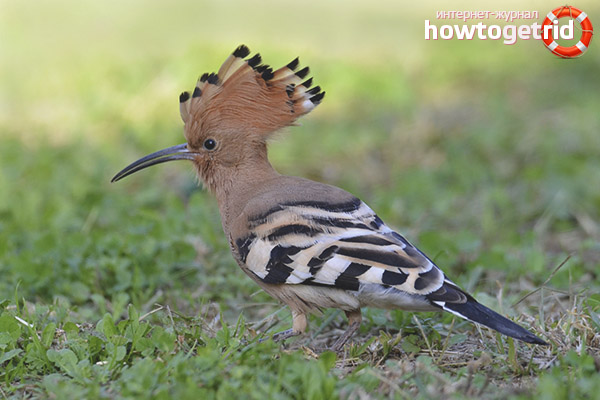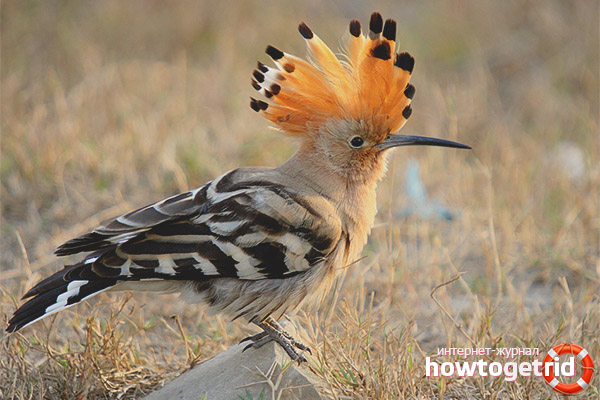The content of the article
It has a relatively small size with a forelock on the head and a thin oblong beak. The main habitat is the south and central part of Eurasia, northern and central Africa. They settle in the flat areas, sometimes they can be seen near fruit trees.
Description
The body length of the bird is 25-30 cm, the length of the wings is 45-50 cm. Hoopoe can be easily recognized by the orange fan on the head, it is small, about 7 cm and is usually folded back, but on the ground the bird can open it. The color of the body, neck and head are different for each species, but the main colors are chestnut and red. It has wide semicircular wings with white and black stripes. The tail is small, has a color similar to wings. The belly is red with pink shades, with dark stripes. The bird has a long curved beak. Her legs are gray or dark with small thin claws. Females and males do not have external differences, and young individuals differ only slightly in the color of their feathers and in the length of their beak and crest.
Hoopoes fly slowly, smoothly and gracefully, while fluttering like butterflies. During their flight, they are quite dexterous and can begin to quickly flap their wings to break away from the predators pursuing them.
Nutrition
They get their food, mainly on the ground, without going into tall grass. Their special beak makes it possible to penetrate deep into the manure, make holes, can also look for small animals near the places of livestock walking. Hoopoe cannot immediately swallow large prey, while on the ground, because of its small tongue, so he first throws it over himself and swallows it. If large bugs fall into his paws, he breaks their carapace, hammering it with its beak.
Habitat
It inhabits the entire southern and central part of Eurasia, with the exception of the islands of Great Britain, the Benelux countries, the Scandinavian peninsula, and on the peaks of the Alps, Apennines and Pyrenees. It is less common in some areas of Germany and the Baltic countries. On the territory of Russia can be seen in some areas of the central part of the country, in the south, in Siberia, in Altai. In the Asian part of the mainland, the bird can be seen almost everywhere, with the exception of desert areas and places with dense forest vegetation. In Africa, can be found north and south of the Sahara. Also often live on island lands, for example, in Japan, Sri Lanka, Taiwan.
You can distinguish birds that lead a settled and migratory way of life. Residents of European lands for the winter fly to southern Africa. Some fly away not so far and nest in the northern parts of the black mainland or the Mediterranean islands. Inhabitants of Siberia and North Asia travel far south - to India, Indochina, Indonesia. Flight dates may vary. It depends on the habitat and subclass of birds. They return from wintering, mainly between February and May. And the departure period is from the beginning of August until November.
The preferred nesting place is plains, meadows or hills without dense and high vegetation, with rare lonely trees. In the mountains can nest at an altitude of 2 km. The most pleasant area for them is the steppe and savannah. They make their nests in tree hollows, crevices, burrows, anthills and piece hollows.
Frequent bird species
Hoopoes have their own family and, depending on size, color and wings, there are such types:
- The hoopoe is ordinary. It can be seen everywhere in Eurasia, northern Africa and many islands.
- The hoopoe is Egyptian. The main place of residence is Egypt, some countries in the south of the Sahara desert. The largest representative of its family has an elongated beak.
- Hoopoe Senegalese. It can be seen in the west and center of Africa. The smallest species with much smaller wings.
- The hoopoe is equatorial. As the name implies, lives in the equatorial regions of Africa from Tanzania in the east to Congo in the west. It has a dark color.
- Hoopoe African. The habitat zone is similar to the equatorial cousin, but differs from them in the red color of plumage and the absence of light stripes on the wings and back.
- Hoopoe Madagascar. Lives exclusively on the island of the same name. Quite large compared to the rest, has a gray or dark pale plumage.
- Hoopoe Eurasian. He lives in the Asian and Middle Eastern parts of the mainland, in Russia. The difference in plumage is a whitish belly and back.
- Hoopoe Ceylon. It lives in the southeastern part of the Far East. It has a bright red color.
- Hoopoe Indian. It is found in areas of India, China, Nepal and Bangladesh. One of the largest representatives, characterized by bright light stripes on its wings.
The closest relative of these species is considered a representative of the family of wood hoopoe - forest hoopoe. The body of this representative reaches 30 cm in length, the plumage of black or dark color without light stripes. Females are distinguished by the head of a light black or brown shade, the male can have a white or light brown color, sometimes green with shine. Lives in equatorial regions of Africa, especially in forests.
Gender differences
Most hoopoes do not have gender differences in color or size. Only some subspecies may differ in small details in the color of some parts of the body.
Breeding
Birds reach puberty at the age of one year. They begin to nest in early spring. Males try to be the first to take the best places and try to show themselves in every possible way. They make loud noises, trying, thereby, to attract the attention of females. Especially often they scream after sunrise and sunset. When the pair was found, the male follows his female. And both of them are looking for a suitable nesting place. One pair of birds can nest in one place for many years.
They try to make nests in hard-to-reach areas (old hollows, crevices, on slopes of rocks or mountains, within the walls of abandoned buildings). If at the time of laying the eggs they do not find a suitable place, then they make them on the ground in a hill of dried leaves or the remains of large animals. They do not strongly line the nests, they only bring a few feathers of leaves or grass. If the nest is in the hollow of a tree, then wood dust or moss is used as a litter.
These birds never remove droppings from their nests, and when they nest, they emit a special liquid that has a pungent and very unpleasant odor. This is a kind of protection against predators, but because of this, people consider this bird unclean.
In one nest there can be up to 9 eggs; they have an oval-shaped, dark gray color. Every day, the female tries to debug the egg. Only the female incubates eggs, the male at this time is looking for food for her. The incubation period is 25-30 days. Chicks hatch blind with a little red fluff, which later gives way to pink or white, and becomes thicker. Both the female and the male feed the chicks, mostly they give small bugs or worms.
The voice of the bird
Hoopoe has a dull voice, the main scream emits in the form of several repeating sounds, similar to "ud-ud." The name of the bird seems to imitate these sounds. Frightened, they scream with a piercing, heartbreaking scream.During the marriage or when they feed the chicks, they make long quiet sounds. Of all the members of the family, only Madagascar has a distinctive voice, his conversations are like a long dull purr.
Natural enemies
Among natural opponents of hoopoes are birds of prey, some mammals, and snakes. They often destroy their nests.
Population

According to the International Union for Conservation of Nature, it was a large species of birds. In recent years, the population in some natural areas has decreased, but the general population is quite large and therefore it makes no sense to classify them as a threatened species. In the Red Book of international trends is classified with the following mark - the minimum risk of extinction.
Interesting Facts
The bird runs pretty quickly and dexterously on the ground. In the case of a close threat, it falls to the bottom, spreads its wings and raises its beak to the sky.
The bird is depicted on the banknotes of the African country of the Gambia.
In 2008, on the anniversary of the existence of the State of Israel, elections were held for the national bird, and most residents chose hoopoe.
Since hoopoe often makes nests in the remains of animals, the scientist Peter Pallas examined the nest of this bird in the human chest. Hoopoe was also chosen by the national bird of Russia in 2016.
Video: Hoopoe (Upupa epops)












Submit